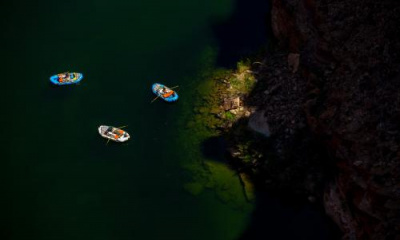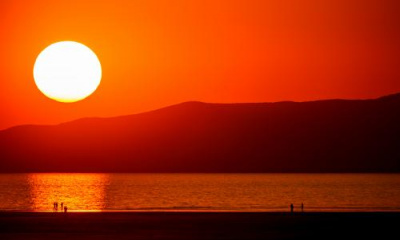The gift has been months in the making, and represents the first major private sector commitment to saving the imperiled lake.
The Church of Jesus Christ of Latter-day Saints, one of the wealthiest and most influential institutions in Utah, plans to donate a pool of water to help save the Great Salt Lake.
The Utah Department of Natural Resources, which helps manage the lake, announced the gift Wednesday morning. The donation amounts to about 20,000 acre-feet worth of shares that the church holds in the North Point Consolidated Irrigation Co. An acre-foot is enough water to support about two Utah households, depending on how prolifically they irrigate outdoors.
“We’re grateful to The Church of Jesus Christ of Latter-day Saints for this generous donation,” Gov. Spencer Cox said in a news release. “This water donation will make a real difference to the lake and the future of our state.”
The governor has been in talks with the church over water for the lake since at least July. The Great Salt Lake sits precariously on the verge of collapse after hitting two record lows.
Although the lake is the nation’s largest saline system, it has run a water deficit of about 1.2 million acre-feet in recent years. This winter’s substantial snowpack, however, will likely raise its elevation by at least a few feet. It currently sits at about 4,190 feet above sea level but needs to rise to around 4,200 feet to reach an elevation that’s sustainable for wildlife, recreation and lake-based industries like brine shrimp and mineral harvesting.
“The Great Salt Lake is a critical asset environmentally, ecologically and economically,” Cox said, “and we all need to work together to protect and preserve it.”
The water donation will be managed through the Great Salt Lake Watershed Enhancement Trust, established by the Utah Legislature last year.
“The Great Salt Lake and the ecosystem that depends on it are so important,” said Bishop W. Christopher Waddell, the church’s first counselor in the Presiding Bishopric, which oversees the faith’s vast financial, real estate, investment and charitable operations. “The church wants to be part of the solution because we all have a responsibility to care for and be good stewards of the natural resources that God has given to us. We invite others to join with us to help.”
Waddell is the keynote speaker Friday at the Wallace Stegner Center for Land, Resources and the Environment’s symposium on “The Future of the Great Salt Lake.”
A Salt Lake Tribune analysis last month found the church owns at least 75,000 acre-feet outright in the Great Salt Lake watershed. That does not include any shares it has in canal companies, which are harder to ascertain because the companies are private.
Many, if not most, of water rights in Utah are held communally in irrigation companies. Pioneers and farmers formed them by pooling their resources to dig canals so they could raise crops and build cities across arid Utah.
North Point Consolidated Irrigation Co. has water rights from 1862 and 1915, sourced from the Jordan River. Older water rights are particularly helpful to the Great Salt Lake because they receive higher priority in times of drought.
The church’s gift will also sustain critical shoreline and wetland habitat in Farmington Bay, according to DNR.
“This donation is invaluable because it’s a permanent, dedicated source of water that will benefit the lake year after year,” Joel Ferry, executive director of the department, said in the news release. “I appreciate the collaborative effort among the church, DNR and conservation groups.”
Marcelle Shoop, director of the Saline Lakes Program for the National Audubon Society and executive director of the Great Salt Lake trust, also expressed her appreciation for the donation.
Utah lawmakers have worked to overhaul the state’s archaic water laws in recent years. Those changes allow irrigators to bank water or lease it to the state for environmental benefits, including the Great Salt Lake.
Farmers across the basin have, so far, been reluctant to participate in leasing.
Religion scholars, environmental advocates and scientists have highlighted the cultural sway the church holds in Utah, and the critical role it could play in rallying residents to help save the lake from becoming a toxic dust bowl.
The lake contributes $1.9 billion to Utah’s economy and supports the vast majority of the state’s wetlands. It’s a critical staging site each year for millions of migrating birds, which are increasingly losing habitat as salty lakes dry up around the West and throughout the world.









